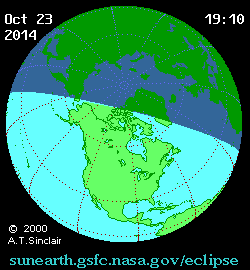How to watch Thursday's partial solar eclipse
A partial solar eclipse darkened the skies of North America Thursday, as the moon crossed between the Earth and the sun.
The eclipse began near the Kamchatka Peninsula in eastern Siberia, and moved east, according to NASA. Skywatchers were able to see the event everywhere in North America except for northern New England and Canada's Maritime provinces, as long as the weather was clear.
Since the eclipse is partial, the sun was never completely covered by the moon's disk, but it was still a dramatic experience as the Earth was cast into shadow.
For residents of the West Coast, the eclipse began in the afternoon -- 1:35 p.m. local time in Seattle, 1:52 p.m. in San Francisco and 2:08 p.m. in Los Angeles -- and was expected to last about two and a half hours. However, stormy weather in the Pacific Northwest interfered with viewing there.
It reached Phoenix by 2:21 p.m. local time, Denver at 3:18 p.m., Chicago at 4:36 p.m. and Dallas at 4:48 p.m.
Farther east, the eclipse began between 5:45 and 6 p.m. local time in Boston, New York, Washington D.C. and Atlanta, but ended a short time later at sunset. Weather was also be a factor in the northeast.
For additional cities and times, NASA posted a list online.
For those thinking of stepping outside to take it in, it's important to take precautions -- DO NOT look directly at the sun. "It is never safe to look at a partial or annular eclipse, or the partial phases of a total solar eclipse, without the proper equipment and techniques," NASA warns.
Gazing at the sun without appropriate filters may lead to so-called "eclipse blindness," a serious eye injury that can cause a temporary or permanent damage to vision. Sunglasses, no matter how dark, are not safe for viewing a solar eclipse.
"Looking directly at the sun is harmful to your eyes at any time, partial eclipse or no," said Alan MacRobert of Sky & Telescope magazine. "The only reason a partial eclipse is dangerous is that it prompts people to gaze at the sun, something they wouldn't normally do. The result can be temporary or permanent blurred vision or blind spots at the center of your view."
One way to watch it safely is use glasses equipped with special solar filters, or through a dark #13 or #14 rectangular arc-welder's glass, which can be purchased at a welding supply store.
You can also create a pinhole projector by poking a small hole in a card, facing it toward the sun and holding a second card about 3 feet behind it in a shadow. You can find detailed instructions here. But again, be careful not to look up at the sun in the process.
There was also a live video stream of the eclipse online courtesy of the Slooh Community Observatory beginning at 5 p.m. Eastern time.
